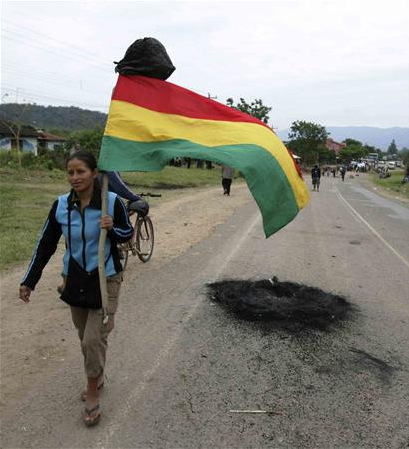WITNESS: The battle of Tiquipaya: Bolivia divided
October 4, 2008 - Reuters
Raymond Colitt is a senior correspondent who heads the Reuters bureau in Brasilia and has about 15 years of reporting experience in Latin America. In the following story he writes about the violent clashes between supporters of President Evo Morales and those favoring more autonomy in opposition-led provinces.
By Raymond Colitt
TIQUIPAYA, Bolivia (Reuters) - "For the unity of Bolivia" read the banner at a road block in the opposition stronghold of Santa Cruz, but deeper division was hard to imagine.

(left) A farmer who supports Bolivia's President Evo Morales passes a roadblock during a pro-government protest in Tiquipaya, 50 km (31 miles) southwest of Santa Cruz, in this September 14, 2008 file photo. In September, Bolivia was rocked by looting, sabotage of gas pipelines, and clashes between government supporters and rebels wanting autonomy for four eastern provinces.
(Photo: REUTERS/Bruno Domingos/Files)
Stranded trucks lined the roadside as our team drove across tropical plains to check reports an army battalion was advancing on Santa Cruz's provincial capital about 30 miles away. Peasant women selling mandarins eyed us suspiciously.
Bolivia was last month rocked by looting, sabotage of gas pipelines, and clashes between government supporters and rebels wanting autonomy for four eastern provinces. At least 18 people were killed. Martial law was decreed in the province of Pando in the latest and most serious round of fighting.
At the roadblock piled with rocks and logs, a small man in a ragged sweater and sandals made from old tires stepped forward, sizing us up with distrust.
He inspected our press cards. I was wary that being American might be a problem among these supporters of Evo Morales, the leftist president of South America's poorest country who had kicked out the U.S. ambassador a week earlier.
 (right) A farmer who supports Bolivia's President Evo Morales holds a Bolivian national flag at a roadblock during a protest in Tiquipaya, 50 km (31 miles) southwest of Santa Cruz, in this September 14, 2008 file photo. In September, Bolivia was rocked by looting, sabotage of gas pipelines, and clashes between government supporters and rebels wanting autonomy for four eastern provinces. (photo: REUTERS/Bruno Domingos/Files)
(right) A farmer who supports Bolivia's President Evo Morales holds a Bolivian national flag at a roadblock during a protest in Tiquipaya, 50 km (31 miles) southwest of Santa Cruz, in this September 14, 2008 file photo. In September, Bolivia was rocked by looting, sabotage of gas pipelines, and clashes between government supporters and rebels wanting autonomy for four eastern provinces. (photo: REUTERS/Bruno Domingos/Files)
We were told to wait for their leader. A lean Che Guevara-like figure in his early 20s with a thin beard and a khaki military cap emerged from the huddle manning the barricade.
"You'll have to excuse us but we're expecting an imminent attack by the unionists," he said softly. The unionists are members of the Santa Cruz Youth Union -- a feared brigade of youngsters who are part of a regional autonomy movement.
A recent poll showed 86 percent of the region's people want greater autonomy from the central government in Andean La Paz, but most say they reject violence.
"I'll talk to you later, but now I urge you to take cover," the young pro-Morales leader said.
BURNING
"They're coming, they're already at the soccer field," shouted shopkeeper Patricia Lopez as she hurriedly stacked chairs and tables and shut the iron gate to her convenience store.
In the panicked seconds before they arrived, burning tires were thrown on the barricade and grubby, barefoot children with sunburnt faces were yanked to safety.
Journalists are frequently targeted during political unrest in Bolivia, so I hesitated about putting on a highly visible flak jacket.
I grabbed a helmet from the car and crouched behind a bush as dozens of unionists emerged through the choking smoke of burning tires, some wearing common dust masks you'd buy at a hardware store or T-shirts tied around their heads.
Immediately, both sides started firing home-made explosive devices, hurling rocks, and unleashing fierce sling shots. The noise of flares, fire bombs and explosions was deafening.
On one side, supporting Morales, were mostly poor peasants of Quechua origin from the highlands. On the other -- the unionists -- were sons of large landowners, settlers and merchants, along with the street children they had recruited.
It was a conflict that tapped long-standing ethnic and regional differences in this country of 9 million people, cradle to one of the most advanced pre-Columbian civilizations.
When the 20-minute battle was over, the peasants had captured four injured unionists, dragging them by their tattered clothes, punching, kicking and stabbing them with sticks.
"Throw them on the fire, treat them like dogs. That's what they would do to us," cried one heavy-set woman, waving in the air a stick with a kitchen knife tied to it.
Crouched and hands tied, the four trembled with fear. One passed out. Another, a 13-year-old called Alejandro, told me he had joined the unionists for a promise of 40 Bolivian pesos.
He was shaking. I wondered whether he even understood what the fight was all about.
"Don't you see what you are doing? We are Bolivians, and we're killing each other," a woman shouted at him.
"Help me get out of here," one of the four pleaded. I was relieved when a leader said they would be handed over to police.
The four captured unionists were taken to hospital, one in a critical condition. Another man died in hospital from head injuries, and a local journalist was beaten.
Recriminations abounded. Opposition leaders said military advisors from Venezuela and Cuba, whose leaders are close allies of Morales, helped the government side, while Morales' supporters had backing from the United States.
I remembered the words of shopkeeper Lopez moments before that battle in Tiquipaya: "It makes me sad, the division of the country, it frightens me."
(Editing by Kieran Murray and Sara Ledwith)